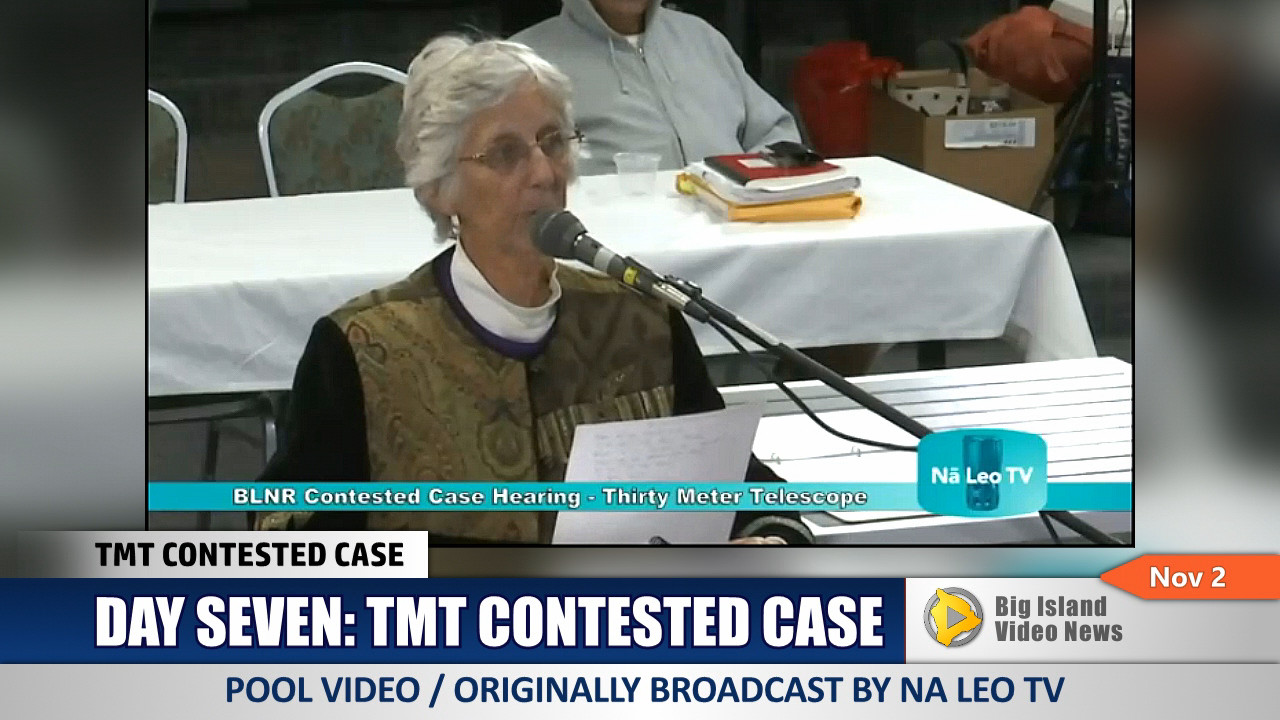
Deborah Ward cross-examines Robert McLaren on Nov. 2 in Hilo.
HILO, Hawaii – Robert McLaren, the Associate Director for the University of Hawaii’s Institute for Astronomy, was cross-examined by opponents of the Thirty Meter Telesope project following his testimony on November 2.
McLaren, a witness called on behalf of the University of Hawaii, focused on the plans in place to govern the removal of observatories from Mauna Kea, called decommissioning, which is to be carried out when the facilities reach the end of their useful life, or when the lease runs out.
In the video above, original petitioners Kalani Flores and Deborah Ward questioned McLaren on the details of the decommissioning.
► MORE from the TMT Contested Case Hearings
TRANSCRIPTS
KALANI FLORES: “Based upon these statements would still be possible to still be possible to build new observatories on existing sites?”
MCLAREN: “Well that would be a version of recycling. But yes.”
FLORES: “Based upon these statements, would still be possible to build an observatory larger than the footprint of the existing or recycled site?”
MCLAREN: “Yes.”
DEBORAH WARD: “Um, what are the consequences of decommissioning early – of the governor’s decision to require early decommissioning?”
MCLAREN: “Could you be a bit more specific?”
WARD: “Are their financial consequences? Is anybody expected to pay for the loss of viewing time?”
MCLAREN: “Well, at any given time, the responsibility for decommissioning is well defined, and so whenever the decommissioning should occur that entity is responsible.”
WARD: “That I understand but if if a facility was expecting that they would have at least until 2033 in viewing time and then that amount of viewing time was cut back perhaps by 10 years… would there be any consequences that the university would have to bear, or the taxpayer would have to bear?”
MCLAREN: “Well, that’s that’s a hypothetical question that I don’t think that situation would arise.”
WARD: “Well if we’re…”
MCLAREN: “Let me be clear: we’re not contemplating any decom… any sort of non-voluntary decommissioning where a facility has a sublease.”
WARD: “I see.”
MCLAREN: “So that – that doesn’t figure in the picture at all. And I think that’s the situation that you’re asking about.”
WARD: “Is the decommissioning of the UKIRT voluntary?”
MCLAREN: “UKIRT. The UKIRT is owned now by the University of Hawaii, so it’s our decision.”
WARD: “And who will pay the decommissioning funds necessary to decommission the UKIRT?”
MCLAREN: “It hasn’t been approved. There’s no notice of intent UKIRT was simply identified in the current projection as what – well, as identified two ways. One, it’s one in the decommissioning plan where our projection is that it’s not something that we would try to continue after 2033. More recently, in – in response to the governor’s request, the university has said that they would… that they were prepared to decommission UKIRT on the TMT timescale in order to meet that request. But since the university owns U- the facility – we are free to do that on our own decision.”
WARD: “So let me ask again: who – what entity would be financially responsible for decommissioning the UKIRT now that the university owns it?”
MCLAREN: “University of Hawaii.
WARD: “I see. And where would they derive those funds?”
MCLAREN: “In as… in connection with our agreement with the United Kingdom to terminate their sublease and for the university to acquire ownership we received funds that were set aside specifically for the purpose of the eventual decommissioning.”
WARD: “OK, well thank you.”

by Big Island Video News9:42 am
on at
STORY SUMMARY
HILO (BIVN) - Petitioners question the UH IfA Associate Director on the plans to remove telescopes from Mauna Kea, in particular plans to decommssion UKIRT.